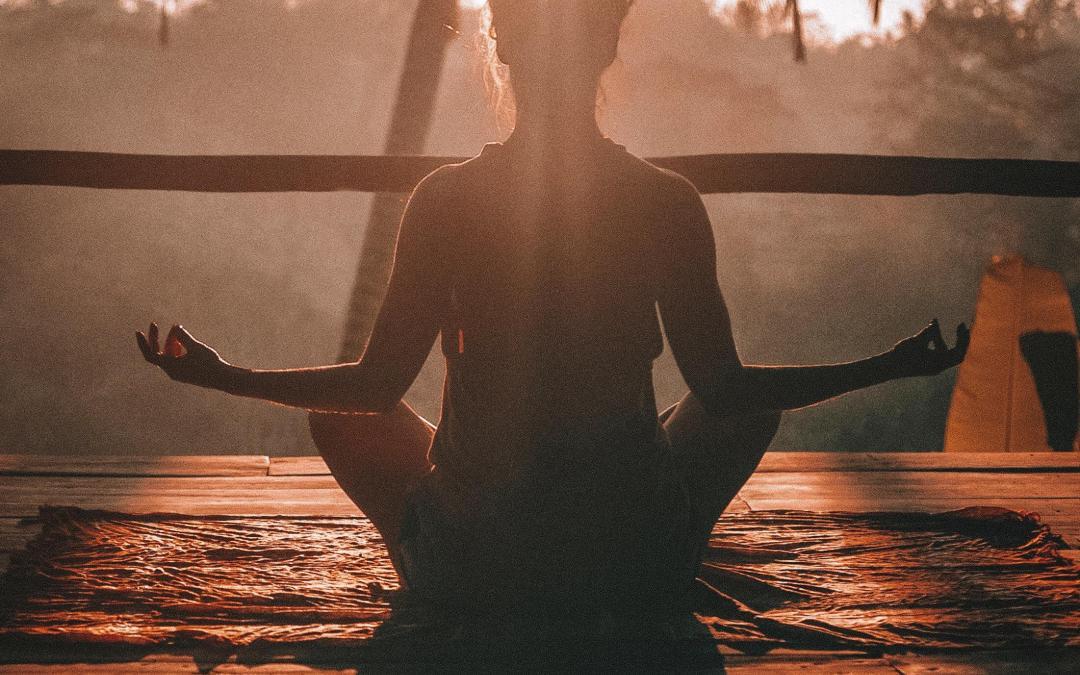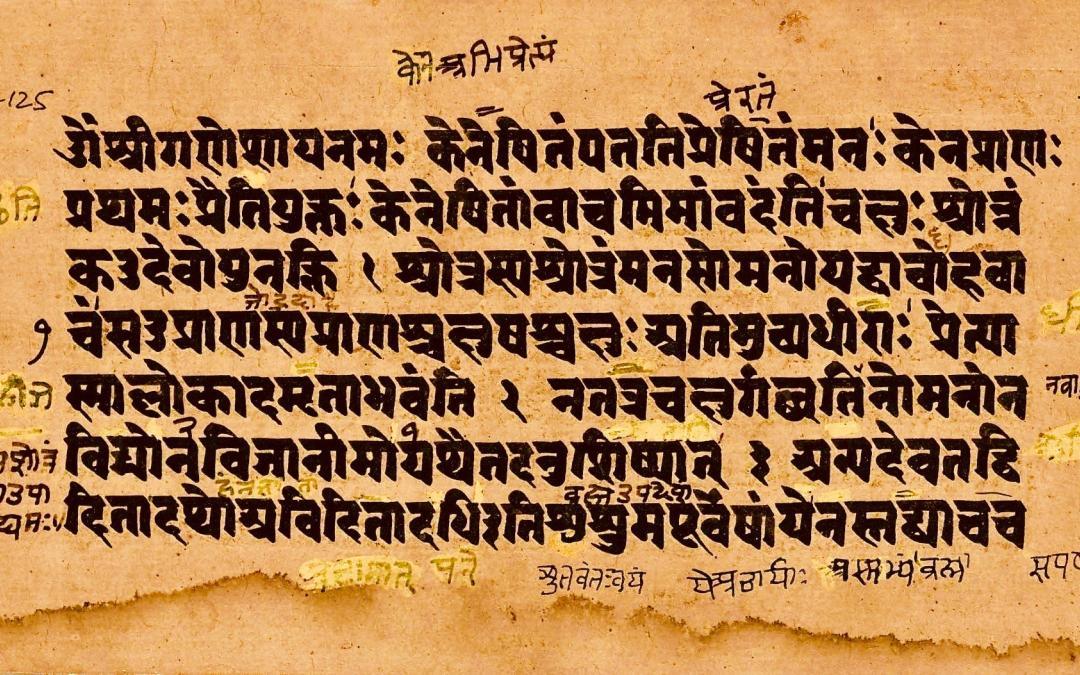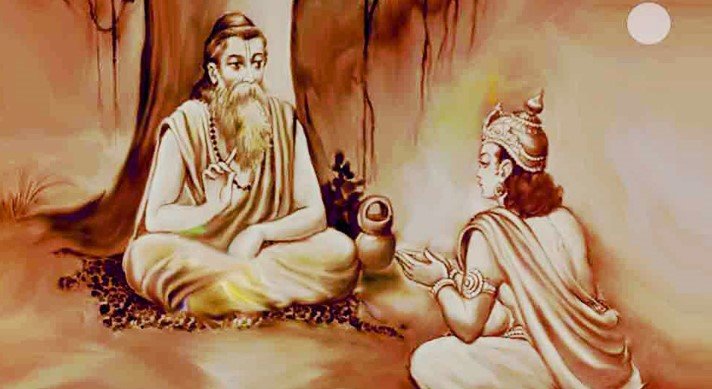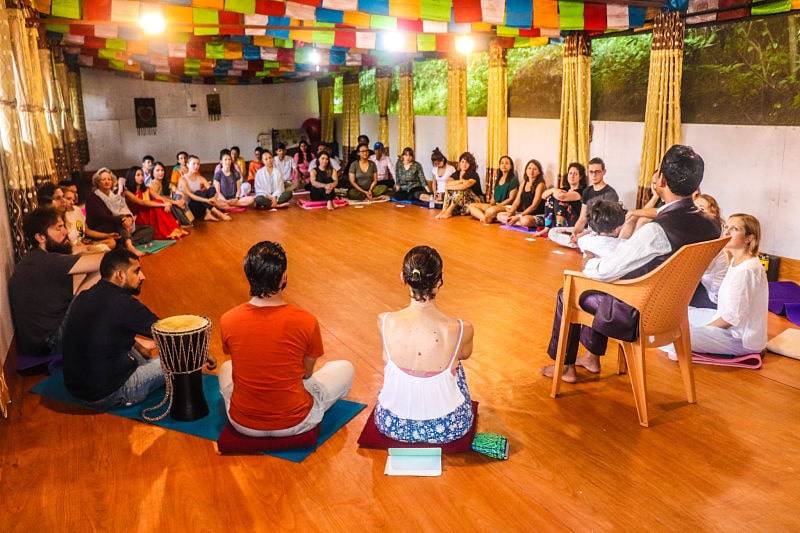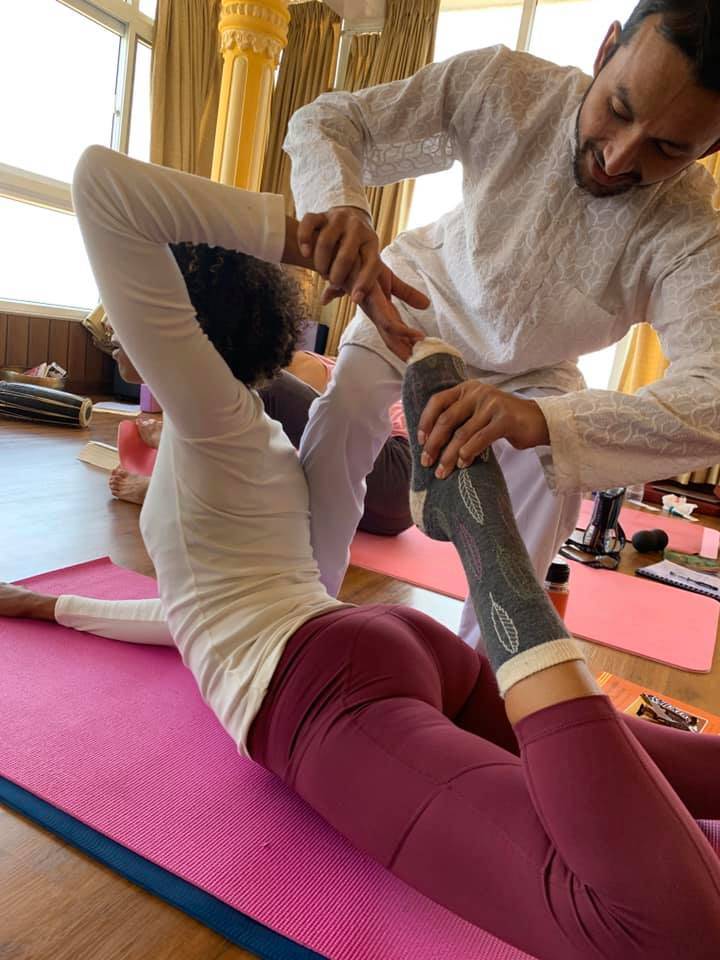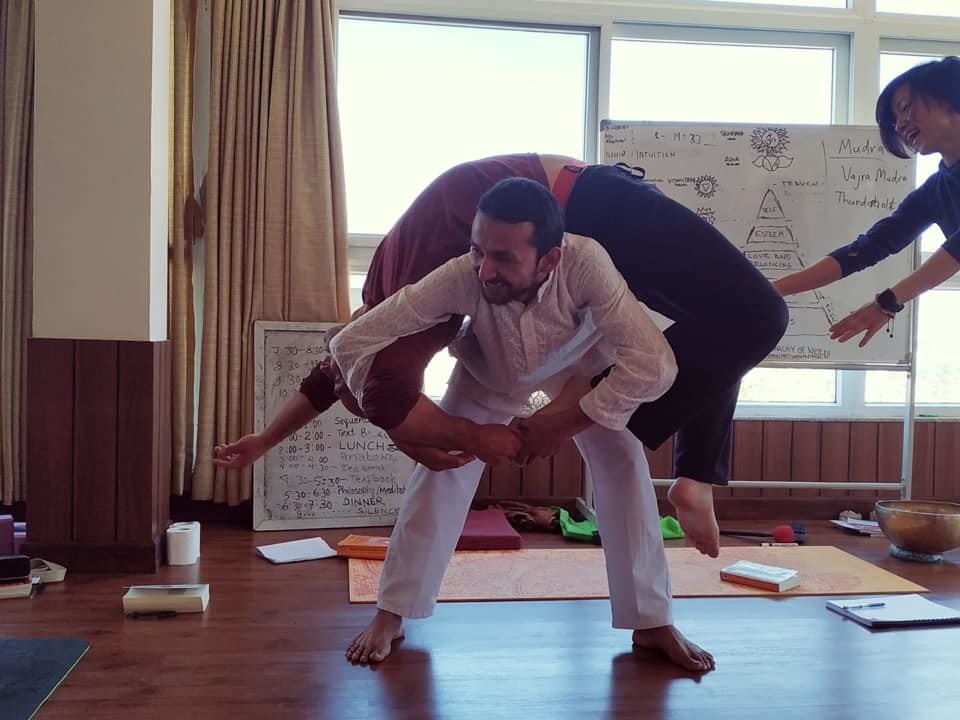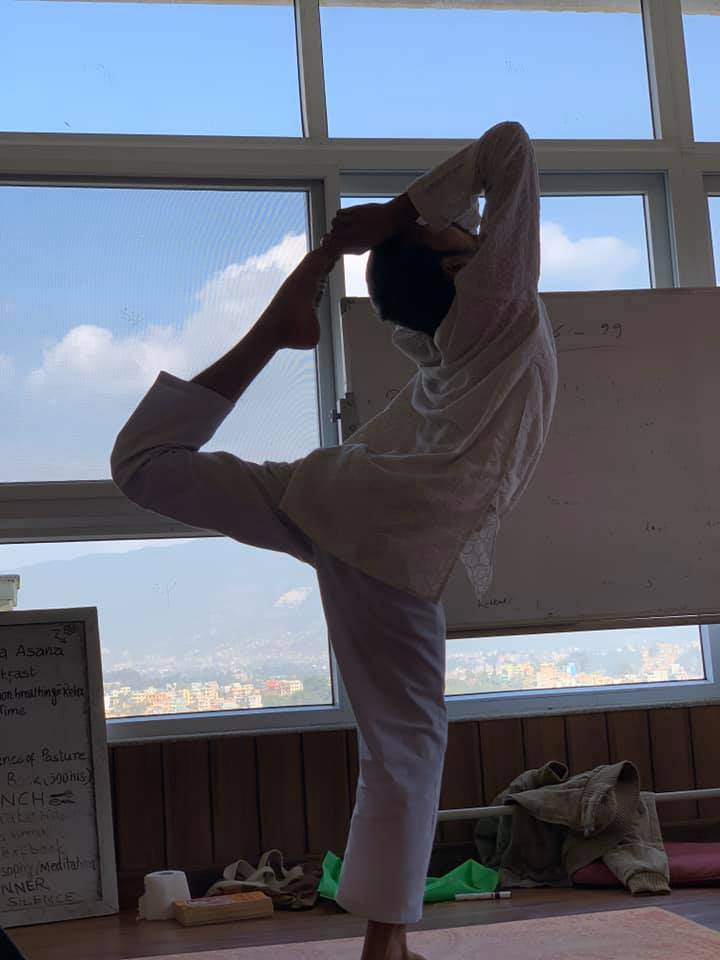
by Tirtha Acharya | Feb 10, 2020 | Yoga
In Sanskrit language, Utthita means extended and Trikona means triangle. Utthita Trikonasana means an extended triangle pose.
Steps to do Utthita Trikonasana
1. Stand in a straight pose like in Tadasana.
2. Slowly jump your legs about 4 feet. Set your arms parallel to the floor.
3. Turn your right leg in 90 degrees and set your left leg 45 degrees.
4. Set your left hand on the left ankle and shin.
5. Stay in this pose at least for 15 minutes.
6. Do the same process from the right leg.
Benefits of Utthita Trikonasana
1. It can improve the digestive system of our body.
2. It helps us to be rid of the stress.
3. It is helpful to the people who have an infertility problem.
4. It strengthens all the parts of our stomach.
Precautions
1. You don’t have to do this pose if you are suffering from diarrhea.
2. You should avoid this pose if you have a headache and low blood pressure.
3. If you have the heart problem, neck pain and high-blood pressure you have to apply special precautions while you do this yoga. For that, you have to consult with your yoga teacher.

by Tirtha Acharya | Feb 10, 2020 | Yoga
Ashtanga yoga includes 8 different parts: Yama, Niyama, Asana, Pranayama, Pratyahara, Dharana, Dhyana, Samadhi. Ashtanga Yoga provides you a detail pathway of 8 karmas that we need to practice as a yogi and practioner of yoga.
Ashtanga Yoga Retreat at NYTT & RC
If you have got a holiday, then this is an ideal place to spend your holiday. This course will be proved to be fruitful throughout your life. If you are conscious of your health and fitness then spare your time with us at least once in a year. This two weeks yoga retreat is fit for all. The beginners will learn a new dimension of life to live happily and harmoniously.
If you are unhealthy or have some health problem then you will get the technique to eradicate your problem without the help of doctor and medicine. You will discover a path of healthy living. If you have already attended some yoga class in previous, then you will expand your knowledge.This retreat will help to deepen your practice. It also welcomes an advanced level of yoga practitioner because this is the place of Yoga to give you spiritual realization through the practice.
This is a favorable place to uplift your realization. This place is situated at the lap of Nagarjuna-Sivapuri National park. So you can enjoy the greenery of the forest. The atmosphere is pure and free from the noise. You can view the entire city from here as it is at a height. The natural lifestyle of this place will be proved to be a boon for yoga practice. This course boosts your energy level and recreates your mental ability.

Ashtanga Yoga Parts:
Here is the brief explanation of Ashtanga Yoga 8 parts which is you will get in Ashtanga Yoga Retreat
Yama (Universal moral commandments): You will learn the importance of morality in the society and its contemporary aspects.
Niyama (Self-discipline and purification): You will learn to be loyal and honest with the self.
Asana (Yoga-postures): You will get information about 84,00,000 asanas and learn more than 100 asanas on a practical basis.
Pranayama (Control, conscious and cessation of breath): You will learn the art of breathing. What the breath actually is, how it is regulated and mastered, etc. are taught.
Pratyahara (mastery of the mind): Mind can be mastered after mastering the breaths.
Dharana (concentration): You will learn how to focus on a particular object.
Dhyana (meditation): You will learn different types of meditation techniques. Especially, mindful meditation is given priority.
Samadhi (Super-conscious stage): This is the highest level of yoga. You will learn its theoretical aspects.
In Ashtanga Yoga Retreat ,the teaching will be on both a theoretical and practical basis by an experienced teacher. After the completion of the course, you will feel that your life has been changed. You will really be pleased with the techniques that you learn here. You will find a mystery in your life. You will feel that life is a blessing. You will be guided in every step for your get betterment.

by Tirtha Acharya | Feb 10, 2020 | Spirituality
Upanisad- 13 main parts of Vedas
The origin of Hindu philosophy is Veda. There are four Vedas: Rig Veda, Sama Veda, Yajur Veda, and Atharva Veda. Each Veda contains four layers of text: the samhitas, Brahmanas, Aranyakas, and Upanisad. Each of these layers has varieties of combinations, however, Samhitas broadly comprises hymns praising Gods. The Brahmanas basically concerned with describing and elaborating Vedic rituals.
The Aranakas and the Upanisad are based on rituals while some sections of it deal with the intellectual and philosophical matters. The Upanisads are also stated as “the fourth and final chapters of Vedas” and reflects the highest purpose of Vedas. These Vedas have different parts. There are 13 main parts of Vedas which are termed as the Upanisad or the Vedanta. They are as follows

4 Different Vedas which includes Upanisad
Rig Veda
Rig Vada has three main Upanisad:- Aitareya, and Kaushitaki. Rig Veda has 1028 hymns and 10600 verses, organized into ten books, called Mandalas. The hymns are devoted to deities and have discussed cosmology. The origin of the Universe and Nature of God, the importance of Charity, and other metaphysical issues are the main interpretation of this text.
Sama Veda
Sama Veda has two main Upanisad:- Chandogya and Kena. This veda is known as Vedas of melodies and chants. Varieties of music, chants, songs, dances etc are the products of Samaveda
Yajur Veda
Yajur veda is the Veda of prose mantra. It has six main Upanisad:- Brihadaranyaka, Isha, Taittiriya, Katha, Kshvetashvatara, and Maitri Upanisad. Basically it has two groups: Black (Krishna) Yajurveda and White (Shukla) Yajurveda. The word ‘Black’ implies “unclear, unarranged, variegated” collection of verses while ‘White’ implies just opposite meaning “clear, arranged, congruent”. It consists veneration, worship, sacrifice and its prayer, particularly mantras etc.
Atharva Veda
Atharva Veda has three main Upanisad:- Mundaka, Mandukya, and Prashna Upanisad. This veda is a guideline in the everyday life. It is composed of 730 hymns and 6000 mantras, divided into 20 books. Atharva Veda covers varieties of topics like magical mantras for all types of healing, sorcery, worldly attainment and richness etc.
The original language of the Upanisad is Sanskrit, containing the central philosophical ideas and concepts of Hinduism. Some of the concepts are shares with Buddhism, Jainism, and Sikhism. It has a key role in the progress of spiritual ideas, making amendment from Vedic style into new ideas and concept. The concept of enlightenment, ultimate truth (Brahma), supreme-soul (paramatma), soul (Atma, the self), karma and yoga, a theory of Karma, worldly existence, purusha (person), prakriti (nature), physical and metaphysical issues etc. are the main theory of it.
Besides, it consists ritual context, a foundation of life, what happens at the time of death, ways of life, the process of life and death, ways of interacting with other, nature and reality, working of the body, what is hell and heaven, what is Universe etc.
It includes vast range including explanation of ritual actions, creation of myths, mysticism, magical and supernatural formulae, genesis of ceremony, explicative conversation about popular teachers, students and royal families, ordering of teachers and disciples, There are more than 200 Upanisad known, out of which first thirteen are considered as main Upanisads. It plays an important role to develop a discursive and intellectual language.
It has raised philosophical debates and questions by revealing different factors of attaining knowledge, including synthesis, analysis, comparison, deduction, introspection, retrospection etc. Among six Hindu Darshanas- Nyaya, Vaisesika, Mimamsa, Vedanta, Samkhya and Yoga; first four do not follow chronology above but they all matter all the vedic Upanisads as Sruti (a timeless revealed knowledge). Rest of the two Darshana Sankhya and Yoga are normally regarded as supporting the vedas.
The fundamental Upanishads were inscribed from about 900 to 300 BCE. The inscription of other different minor continued. It has been found that hundreds of other texts with the name ‘Upanisad’. Although test denoted as ‘Upanisad’ have been continued to compose up till the present time, the majority of the texts were composed between the 2nd and 15th centuries. Scholars have set these books in different groups corresponding to common themes, such as Saiva Upanisad ( Upanisad on Lord Shiva), Yoga Upanisad, Vaisnava Upanisad (Upanisad on God Vishnu), Samnyasa Upanisad (Upanisad on renunciation) etc.
Some Topics Covered by Upanishad
Among the widely discussed topics in Upanishad, Atma (Soul, the self) is one of the most important topics. The lexical meanings of Atma have covered a broad range including ‘breath’, ‘spirit’, and ‘body’. After the evolution of Upanishad, its meanings elaborated in various words like- an essence, a life-force, consciousness, energy, or ultimate reality.
A well-known teaching has been found in Chandogya Upanishad. A character, Udayakala Aruni, explains to his son Svetaketu that one can know Universal material substance from particular stuff. For example- by means of something made up of clay, one can know clay entirely; by means of an ornament made from gold, one can know the gold; by means of a needle; one can know iron etc
Objects are not created from anything but transform from one matter to another. Creation is influenced from ‘Satkaaryavaada’ theory which means the theory of cause and effects. Udayakala continued his explanation comparing a series of conclusion with experimentally observable natural process to reveal that the self is a metaphysical schema present in all living beings.
For that, he used honey as an example. Bees collect it from the different sources and gather together to make an undifferentiated whole. Similarly water flowing from different rivers and cannels form the ocean without and distinction. The banyan tree cannot be seen in the seed.
The dissolved salt in the water cannot be seen. Likewise, the self, pervaded in the human body cannot be seen. The phrase “you are that” (tat avam asi) is frequently used by Udayakala to explain that the soul (self) actuates the same way in him as it operates in all creatures.
The self is both tenor that connects the part with the Absolute and the eternal that remains static even while taking different forms or shapes. In this way, Udayakal explains about the self to his son as a life force that animates all creatures. Thus, the various subject matters have been discussed in Upanishad.

by Tirtha Acharya | Feb 10, 2020 | Yoga
Sirsa means head in the Sanskrit language so Sirsasana means head standing pose. This pose is regarded as the king of all poses.
Steps to do Sirsasansa
1. Set yourself in the Bajrasana and bend forwards.
2. Set your hands up-to-the elbow and head on the ground.
3. Put your head on your intertwined fingers.
4. Move your body forward and lift your buttocks up so that your torso becomes 90 degrees to the ground.
5. Slowly bend your knees and try to lift up your legs.
6. Lift your legs towards up by bending your knees.
7. Now make strait your both legs.
8. Stay in this pose at least for 15 seconds.
9. Slowly reverse the action what you did when you went up and rest in sometimes in Sasankasana.
Benefits of Sirsasana
1. This asana is useful for the healthy brain.
2. This yoga helps with headache and migraine.
3. It is useful for diabetes.
4. It is also helpful for the thyroid problem.
5. It increases our brain power.
6. It is useful to get rid of hair fall.
7. It is very useful for anxiety.
8. It improves our eye vision.
Precautions
1. You don’t have to do this pose if you are suffering from the back problem.
2. You should avoid this pose if you have a headache and high blood pressure.
3. If you have neck pain and low-blood pressure you have to apply special precautions while you do this yoga. For that, you have to consult with your yoga teacher.
4. You don’t have to do this yoga if you have the heart problem.

by Tirtha Acharya | Feb 10, 2020 | Yoga
Guru Sishya Relationship- Ancient Culture
Guru is a Sanskrit word that connotes “master” or “teacher” with certain knowledge. The literal meaning of guru is “a person who dispels the darkness and takes towards the light. According to Vedic philosophy, Guru is someone more than a teacher. Guru is the light of life to show the right path. He illuminates the dark part of life and gives freedom from all delusion. Human beings have different types of problems in life while living in the world. So remove the darkness of sishya’s ( student) life guru sishya relationship is very important.
They try to escape from the problems. The Guru makes people understand the problems. With the proper understanding, people can live happily even in problems. It is the guru who helps to find the true self and the destination. Traditionally, the figure of the guru is a “counselor, who helps concoct values, shares knowledge, and an ideal of life and who beghasts to evolve worldly and spiritually. In guru sishya relationship, Guru helps to discover the inner potentialities of the disciple (sishya).

The oldest concept of Guru is found in the Vedic text of Hinduism. Many Gurukul – schools run by guru were established according to Hindu Tradition by the first millennium BCE. The guru used to transfer the knowledge Vedas, Upanishad and various texts of Hindus. Besides Hindus, there were other different types of traditions like Jainism, Buddhism etc had also these types of practices.
The purpose of these all traditions was to give right guidelines in the life of Disciples. Thus, there is great need of Guru for the proper guidance in life. But the issue is how to find a guru. The guru can be one or many as per the requirements. Some gurus are limited to a particular subject matter. For example, Arjuna (a character of Mahabharat) had many Gurus; for Archery- Dronacharya; for singing, dance and music- some Gandharvas of heaven; for some special weapons- Lord Shiva and Indra; for life guiding- Lord Krishna. All these knowledge is possible only after guru sishya relationship.

Dattatreya had twenty-four Gurus to learn different things. The gurus were: Earth- to learn the qualities of forgiveness, unselfishness, and energy to bear the troubles; Air- to learn the quality of aliveness, consciousness, detachment, stillness in movement, present in all but not being affected by the motion and alteration within it like pervading everywhere yet uncontaminated, carrying odour but being odour etc.;
similarly in guru sishya relationship, the guru were: Sky-to learn that deeper mind is like the sky: incomputable and unobservable holding thoughts and feelings like clouds, seeming finite but in fact limitless in its potentialities; Water- supports all life, nourishes, purifies, refreshes; Fire- destroys all that is gross, and impure which reminds freedom from the defects of Avidya; Moon- seems changeable, wax and wane yet no factual change. In the same soul is unchangeable. Sun- to learn egolessness and omnipresence; Pigeon- from pigeon he learned that attachment and yearning destroys spirituality within us.
Python- to learn the value of surrender; Ocean- to learn freedom from disturbance; Firefly- to learn infatuation leads to destruction. Bee-takes necessary things without harming or disturbing other; Elephant- Dattatreya learned that one should not be distracted by sensual desire when one has the highest goal; Honey-gatherer- valuable time should not be wasted but should apply to seek the self.
Deer- to be aware of own weak point and alert; Pingala- learned to be free from desire, attachment, acquired wisdom; Sparrow-when the enemy is stronger one should not try for possession fight; Child- learned to live moment to moment without being hanged for past and future; Girl- learned that one should walk alone on spiritual path to get perfect peace; Archer-one pointed concentration; Snake-learned to abandon crowd, increase awareness; Spider-reminded that the divinity that casts the cosmos cut of itself and at the end gathers it back into itself; Wasp-to know Lord is to become lord.
In this way, a person can have many Guru as well. Guru can be of different types like Yogi guru, Jnani Guru, Tantric Guru, Brahmanishta Guru, Female Guru, etc. However, there is a special Guru how guides to final goal i.e. enlightenment.The disciple should make such a relation with guru so that he could get required knowledge without any disturbance or blockage.
Too much intimacy and too much far relation is not good for acquiring knowledge. The disciple should have full of devotion and faith towards the Guru. However faith and devotion should not be blind. When you go to guru go to him with empty mind possessing no thoughts. Just listen what he says. Be open to Guru, hide nothing from him. While visiting to Guru, clothes should be simple.

Wears and ornaments should not display worldly riches. in this guru sishya relationship, One (student) should not go empty hand to Guru. The disciple should offer some parcel according to his capacity. Parcel should not show richness but devotion. Parcels can be fruits, favorite dish, clothes etc. If guru is in need of money, it is better to offer him money as well.
These offering should be with spiritual emotions (called Bhava). The disciple should offer obeisance to guru at home, ashram, or road anywhere he meets. While offering obeisance you can place forehead on Guru’s feet or other alternative methods. Whatever is learned from the Guru, one should put into practice. The disciple should continuously walk on the spiritual practice in order to be able to serve the guru. The regular spiritual practices purify the disciple.
The practices occur easily and spontaneously during the time of serving Guru. So, disciple should take proper advantage of it. Many disciples have the habit of forcing Guru to eat though he is refusing to eat. Whatever is offered to guru, if he just touches then it is acceptance. Sometimes he may be unable to eat due to many reasons like-controlling in dietary, health status, age, interest, etc.
The disciple should not keep anything in mind, or act from which Guru feels discomfort. Sometimes inviting the Guru at home is good. But sometimes guru himself moves to the residence of disciple if he is real devotee. Guru may move freely in and around the house of disciple.

Over-service to guru (like keeping car at the doorstep, fetching water to wash hand etc.) may make guru invalid. This is not good. One should never sit on Guru’s seat from where he preaches or teaches. One should never advice guru without permission. If disciple is at guru’s home during function like wedding etc., disciple should consider own home to do different types of work.
If guru is sick or unconscious provide him treatment and medicine prescribed by doctor. However, if guru is conscious then he should be forced. The disciple should do nothing whit out the will of guru. It is meaningless to go to guru for paying obeisance during his illness. When guru renounces his body one should go to pay last obeisance as son does for his father.

If Guru scolds, reprimands, beats etc. the disciple should not be attached to such activities. The disciple should t analyze the behavior of Guru. Instead of analyzing the Guru’s or saints habits one should continue to walk on the spiritual path and service them. This is because analyzing reason gives no benefits, understanding the real reason is beyond the intellect. So, in our scriptures, guru sishya relationship should be very strong, intimate, and sishya always need to follow the guru.

